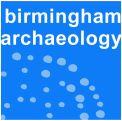Life, Work and Death in Birmingham, AD 1100-1900
Birmingham Archaeology, 2017. (updated 2020) https://doi.org/10.5284/1046277. How to cite using this DOI
Data copyright © University of Birmingham unless otherwise stated
This work is licensed under the ADS Terms of Use and Access.
Primary contact
Historic England
1 Waterhouse Square
138-142 Holborn
London
EC1N 2ST
UK
Tel: 01793 414700
Fax: 01793 414707
Resource identifiers
- ADS Collection: 2857
- DOI:https://doi.org/10.5284/1046277
- How to cite using this DOI
Introduction

The overall aim of this project has been to provide a holistic overview of the archaeological remains recorded in Birmingham City Centre within the study area. This overview is intended to broaden the knowledge of archaeological evidence for the historic development of the City and inform future decisions about its above and below-ground heritage. The project was initiated by Birmingham City Council and English Heritage in 2006, with a Project Brief prepared by CgMs on their behalf. The project was then undertaken by Birmingham Archaeology, with work starting in May 2007.
Despite the large amount of archaeological work undertaken within the study area, it was felt that the lack of published work and dissemination has led to fragmentation of the results of investigations and, subsequently, of the understanding of Birmingham’s historic development. Moreover, individual investigations undertaken are often seen on a site-by-site basis and not brought together within a regional or national context. The aim of the current project, therefore, has been to synthesise this information, to provide a holistic overview of Birmingham’s development and archaeological heritage. The results of this will be two-fold. In the first instance, better understanding of the study area’s historic environment will inform future decisions about its above and below-ground heritage. This greater and more accessible synthesis of investigations will, in line with Birmingham City Council’s Archaeology Strategy, facilitate archaeological responses to future development in the city. The provision of informed advice for the management of archaeology within an ever-changing urban environment like Birmingham’s city centre is vital for the protection of archaeological remains in the context of and without stifling of new development.
In order that the project was undertaken within an achievable and realistic programme, certain boundaries were put in place early in its development. Perhaps most pertinently, the project did not intend to produce a definitive account of Birmingham’s development and heritage. Moreover, an emphasis on the results of developer-funded investigations aimed to highlight the huge contribution made by the work undertaken within the planning framework and to give account of that work. Original research was not undertaken; the point of the project has been to collate, synthesise and disseminate in order to highlight gaps in our current knowledge and highlight potential – not to research those gaps in any detail. Thus, without undertaking large amounts of additional research and investigation, what is included in this report are essentially a few individual pieces of a very complex jigsaw.







